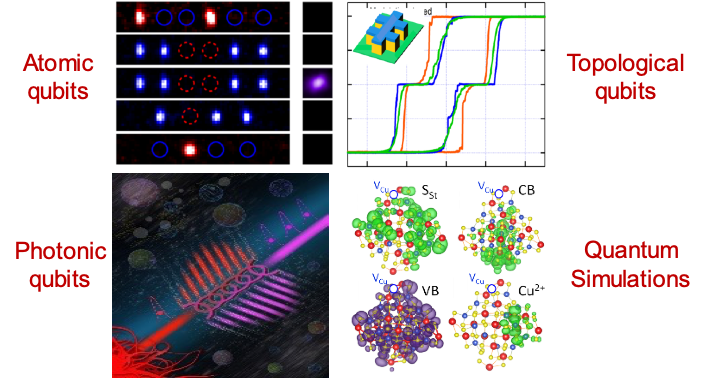NSF PhD Quantum Research Traineeship
NRT-QISE: Accelerating Interdisciplinary Frontiers in Quantum Sciences and Technologies (AIF-Q)
1. NSF Research Traineeship (NRT) goal
Quantum sciences and technologies has made remarkable advances in recent years, through controlling coherence and entanglement, achieving transformative flagship milestones in computation, communication and sensing. In this NRT program, we combine domain-expertise from Chemistry, Computer Science, Electrical & Computer Engineering, Mathematics, Materials Science & Engineering, Neurology, and Physics into an integrated campus-wide traineeship on Accelerating Interdisciplinary Frontiers in Quantum Sciences and Technologies (AIF-Q). Our quantum science and engineering NRT AIF-Q training consists of integrated research thrusts on Atomic Qubits (Thrust Layer 1), Topological Qubits (Thrust Layer 2), Photonic Qubits (Thrust Layer 3), and Quantum Simulations (Thrust Layer 4). These thrust layers are interconnected and supported by our three core expertise in Quantum Materials and Light-Matter Interactions (Core Pillar A), Microwave-Optical Spectroscopy (Core Pillar B), and Quantum Algorithms and Error Correction (Core Pillar C).
The NRT faculty consists of Profs. Chee Wei Wong, Eric Hudson, Kang Wang, Anastassia Alexandrova, Katherine Narr, Lara Dolecek, Wes Campbell, Louis Bouchard, and Dr. Jessica Martone. The traineeship project coordinator is Jiahui Huang. Our external partners are California State University Long Beach, Mount Saint Mary’s University, Lawrence-Livermore National Laboratory, Los Alamos National Laboratory, HRL Laboratories, Google and Sandia National Laboratory.
2. NRT AIF-Q convergent research
Enabled by recent advances in novel quantum materials, quantum algorithms and error correction, quantum simulations and computation, the interdisciplinary PhD training of engineers and scientists in quantum-accelerated science and technology is timely and highly sought after in leading industry, national laboratories, and academic institutions. Targeted frontier application platforms include quantum simulations, processors, interconnects and networks, and sensing. The below Figure illustrates our four Thrust Layers.
3. Features of our NRT AIF-Q traineeship
Central to the four Thrust Layers and Core Pillars is the interdisciplinary graduate education and research training. Our training program consists of interdisciplinary 3-faculty advising and mentoring, laboratory rotations, cross-cutting quantum science and engineering course offerings, industry placement-industry-advising, entrepreneurship, formative-summative external assessments. The 3-faculty advising and mentoring is overseen by Prof. Lara Dolecek. The laboratory rotation is overseen by Prof. Wes Campbell. Our program has a particularly strong emphasis on increasing the representation of women and minority students in quantum science and engineering, through broad outreach recruitment and mentoring. The diversity recruitment and mentoring is overseen by Prof. Katherine Narr. The evaluation and assessment methodology is with Dr. Jessica Martone, our external professional evaluator.
4. NRT AIF-Q traineeship eligibility, priority criteria and application
US citizens and permanent residents in frontier quantum science and engineering training are eligible to apply. Priority is given to applicants of diversity representation. Cross-disciplinary co-advised training, with laboratory rotation, is strongly encouraged. Traineeship application package is simple, consisting of: [1] resume, [2] graduate and undergraduate transcripts, [3] cross-advised research statement on quantum science and engineering achievements (2 to 3 paragraphs is sufficient), [4] equity, diversity and inclusion statement (2 to 3 paragraphs is sufficient), and [5] example published papers if any. For interested applicants, please send your application to ucla.quantum.nrt@gmail.com by December 31st each year. The fellowship committee will select in February of each year for a Fall start date.
5. NRT AIF-Q encouraged classes
* denotes classes also cross-listed in the Masters of Quantum Science and Technology (QST) curriculum
Thrust Layer 1: Interfacing Atomic Qubits. Chemistry: C215A and C215B Quantum Chemistry: Methods*. CS: CS 239 Quantum Programming. ECE: ECE 241A Stochastic Processes; ECE 270 Applied Quantum Mechanics; ECE 271 Laser Theory. Math: Math 259AB Operator Algebras in Hilbert Space. Math M268B Topics in Functional Analysis for Applied Mathematics and Engineering. MSE: MSE 271 Electronic Structure of Materials. Physics: Phys 213A and 213B Advanced Atomic Structure*. Phys 213C Molecular Structure*.
Thrust Layer 2: Interfacing Topological Qubits. Chemistry: C276A Group Theory and Applications to Inorganic Chemistry. C280 Solid-State Chemistry. CS: CS 251A Advanced Computer Architectures. ECE: ECE 221A and 221B Physics of Semiconductor Devices I and II; ECE 279AS Special Topics in Physical and Wave Electronics. Math: Math 256AB Topological Groups. MSE: MSE 247 Nanoscale Materials: Challenges and Opportunities. Physics: Phys 241A-C Solid-state Physics. Phys 242C Topology of Condensed Matter. QST: QST 203 Theory of Quantum Devices*.
Thrust Layer 3: High-dimensional Optical Qubits. Chemistry: C213B Physical Chemistry: Molecular Spectroscopy. CS: M282A Cryptographic Protocols. CS 256A Advanced Scalable Architectures. ECE: ECE ECE 274 Optical Communications and Sensing. Math: Math M209A Cryptography. MSE: MSE 296 Advanced Topics in Mat. Sci. and Eng. Physics: Phys 230A-D Quantum Field Theory. QST: QST 210 Lab Module 1*.
Thrust Layer 4: Quantum Simulations and Many-body Physics. Chemistry: C222 Mathematical Methods for Chemistry. C226A Computational Methods for Chemists. CS: 230 Software Engineering. ECE: ECE 232A Stochastic Modeling. Math: Math 270C Computational Linear Algebra. MSE: MSE 270 Computer Simulations of Mats. Physics: Phys 215C Quant. Statistical Mechanics and the Many-Body Problems. QST: QST 202 Intro. Quantum Info*.
Core Pillar A: Quantum Materials and Light-Matter Interactions. Chemistry: C215C Advanced Quantum Chemistry. C240 Bionanotechnology. C267 Nanoscience and Chemistry. CS: CS 260 Machine Learning Algorithms. ECE: ECE 223 and 224 Solid-State Electronics I and II. Math: Math 269A Numerical Methods. MSE: MSE 201 Principles of Materials Science. Physics: Phys 235 Group Theory and Quantum Mechanics. QST: QST 211 Lab Module 2*.
Core Pillar B: Microwave-Optical Spectroscopy. Chemistry: C213B Molecular Spectroscopy. ECE: ECE 221C Microwave Semiconductor Devices. Math: Math 202AB Mathematical Models and Applications. MSE: MSE 225 Materials Science of Surfaces. Physics: Phys 221A-C Quantum Mechanics. Phys 242A-B Advanced Solid-state Theory. Phys 268 Seminar: Spectroscopy. Neuro: M206 Neuroengineering. Neuro 260 Signal processing for neuroscientists. Psyctry: Functional Neuroanatomy for Neuropsychologists. QST: QST 212 Lab Module 3*.
Core Pillar C: Quantum Algorithms and Error Correction. Chemistry: C222 Mathematical Methods for Chemistry. CS: CS 239 Programming Languages for Quantum. ECE: ECE 230D Algorithms and Processing in Communications; ECE 231A Information Theory: Channel and Source Coding. Math: Math 260 Introduction to Applied Mathematics. Neuro: M220 Biology of Learning and Memory. QST: QST 201 Intro. to Quantum Computing*. QST 205 Quantum Programming*. QST 206 Quantum Algorithms*.
